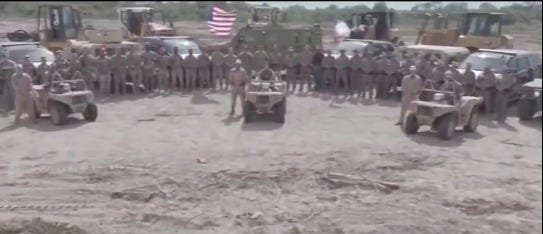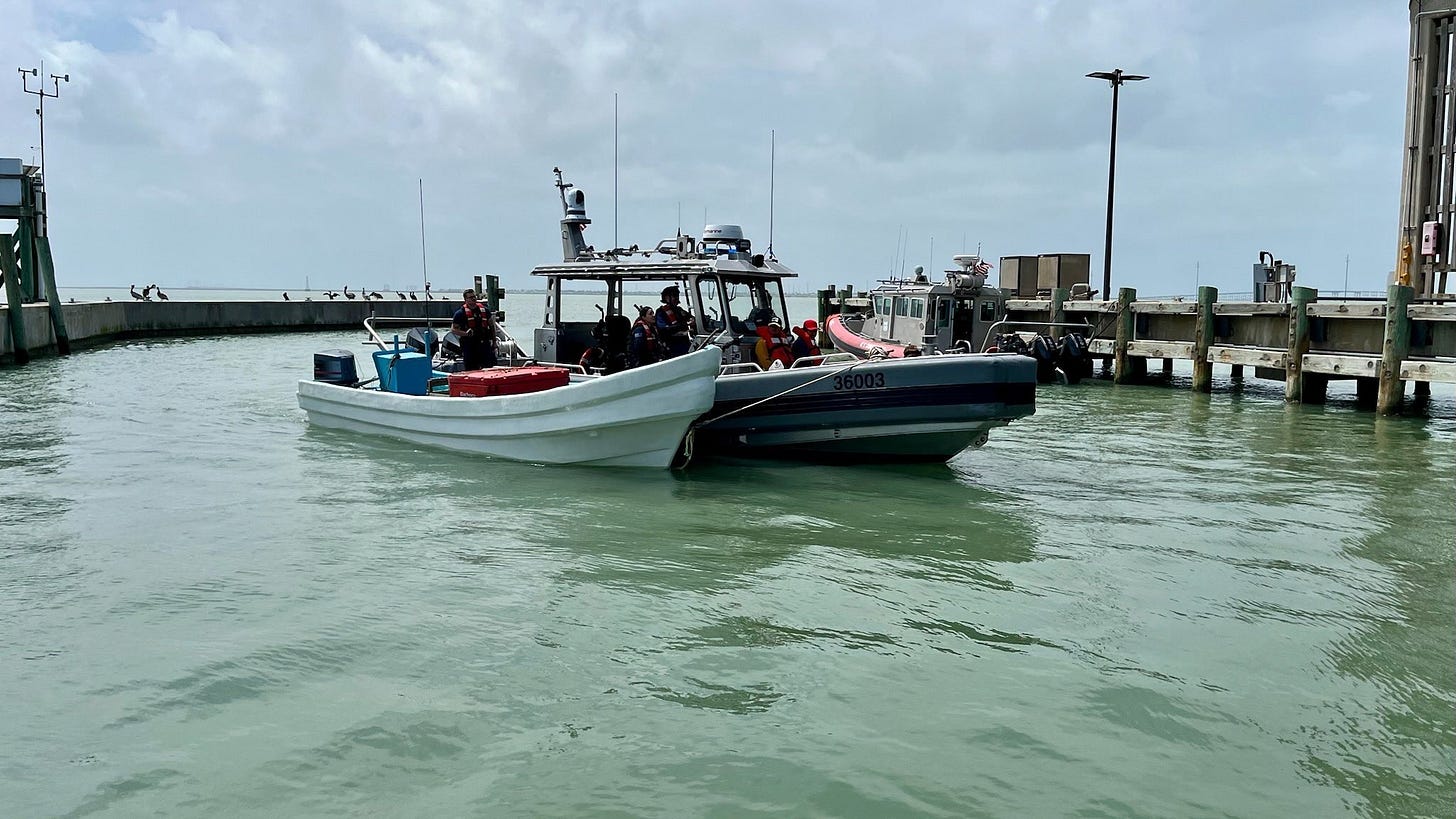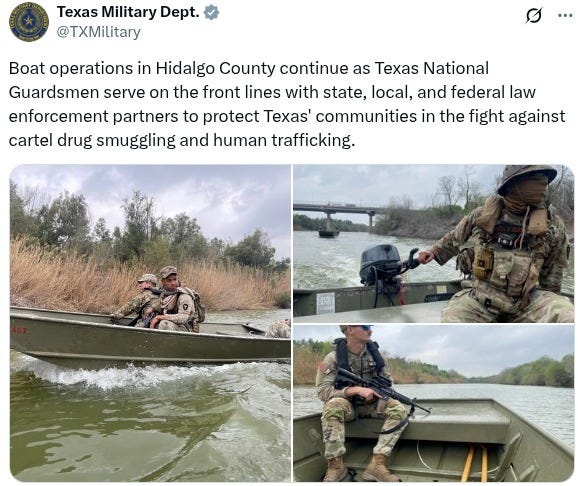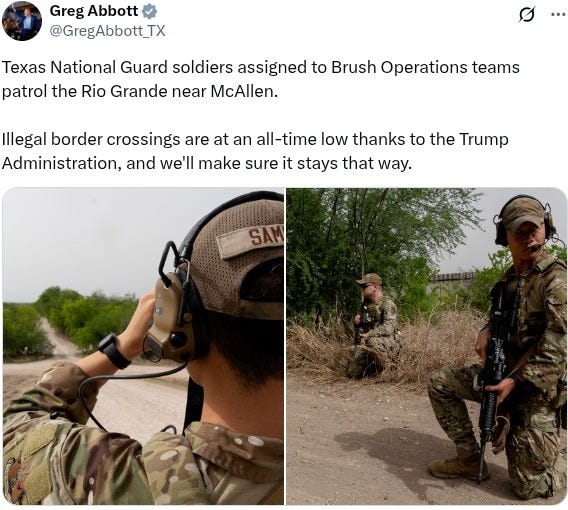Military Boosts US Southern Border Security
A look at early results of border militarization

We’re breaking with the format of our usual weekly US Border Newsletter to offer a deeper dive into ongoing developments along the Southern Border with Mexico, where the Trump Administration continues to increase the presence of US Military Forces on both land and sea (with a look at some early results):
In South Texas, National Guard Troops assigned to "Operation Lone Star" are denying cartels from returning to what once was a "no man's land" island on the Rio Grande used as a smuggling base, which has since been claimed as state land by Texas.

One day after getting underway from San Diego, the Naval Destroyer USS Spruance helped maintain radar contact on a cartel smuggling vessel and vectored in the US Coast Guard Cutter Forrest Rednour along with a US Customs & Border Protection Coastal Interceptor Vessel - resulting in the apprehension of 13 people involved in a human smuggling attempt.

Meanwhile, in the Gulf, US Navy Secretary John C. Phelan paid a visit to the USS Gravely, which set sail on its border security mission two weeks ago:
"It was a privilege making my first trip at sea aboard USS Gravely, the first warship to patrol the Gulf of America. The American people can rest easier knowing this incredible, combat-tested crew has the watch." - Secretary of the Navy John C. Phelan

Elsewhere in the Gulf, the Coast Guard interdicted and detained 8 Mexican Cartel fishermen engaged in illegal fishing and seized approximately 150 pounds of Red Snapper in federal waters off South Texas Friday.
Coast Guard Station South Padre Island boat crews, in coordination with Coast Guard Sector Corpus Christi Command Center and Coast Guard Air Station Corpus Christi aircrews, detected and apprehended a pair of Mexican Cartel "lanchas" north of the Maritime Boundary Line (MBL) in the Gulf.

The Mexican boat crews were turned over to US Customs & Border Protection Officers. The two "lanchas" and all gear aboard were seized by the Coast Guard.

The illegal poaching and trade of red snapper is a revenue stream for the Gulf Cartel. Lanchas are also used to smuggle drugs and migrants from Mexico into South Texas.
The Coast Guard has tripled its Southern Border Fleet since January.
Back on land, US Border Patrol Agents are continuing to closely work with their US Military counterparts. In El Paso, Agents and Soldiers are participating in joint briefings to better coordinate their activities before going out on patrol:

Texas Army National Guard Units are also assisting US Federal Agents through highly-visible river patrols on the Rio Grande to challenge Mexican Cartel attempts to cross the border to conduct human and drug smuggling - as well as gunrunning operations.
While North of the Rio Grande, Texas troops assigned to Governor Greg Abbott's "Operation Lone Star" Border Security Mission are also conducting regular patrols of remote ranchland to assist Border Patrol Agents in their mission of preventing Mexican Cartels from illegally crossing the river to carry out drug and human smuggling operations:
Meanwhile, the Border Patrol continues to swear-in Texas National Guard troops (as many as 750 at a time) to give them the legal ("Title 8") authority to enforce federal immigration laws along its 1,254-mile-long border with Mexico.
It’s important to also note the downside to the militarization of the US Southern Border.
In the remote “Big Bend” area of West Texas, the arrival of US Army Stryker Armored vehicles conjures up painful reminders of the May 20, 1997, killing of an innocent teenager by a US Marine assigned to a Federal Anti-Drug Operation there.
Esequiel Hernandez Jr. was tending his family's goat herd near the border when the shooting (under murky circumstances which are disputed to this day) occurred.

As one resident told The Big Bend Times, “We have felt perfectly fine without military presence. Border Patrol does their job. I don’t know what other agenda is going on, but it’s not like these people are rushing over with guns and knives to warrant tanks and a military presence.”
Do you support the militarization of the US Southern Border?
Share your opinion in the comments on this week’s US Border Newsletter!
I remain committed to delivering a US Border Newsletter that is not only educational and insightful but also engaging and easy to digest in five minutes or less.
(How am I doing? Let me know in the comments!)
Abrazos,
Jack Beavers








Boost up the northern border while you are at it. Canada has bigger fentanyl labs than Mexico, no minimum sentences for trafficking, and free trade of fentanyl precursors.
https://open.substack.com/pub/1911ranch/p/chin-ada-a-drug-lords-playground?utm_campaign=post&utm_medium=web
I am! I have a rare disease and I am retired. All of my extra money goes for medical expenses.